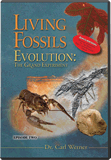Whale “Evolution”?
Hall of Life—Ocean Life Exhibits
on January 18, 2016Whales are thought by evolutionists to have evolved from land mammals. Many museums present a nice, orderly succession of fossils that supposedly show this transition from land to water. However there are many problems with the idea that a land animal could turn into a water mammal.
- Whales do not have the pelvis that land mammals do. If they did, they would crush it with the movements of their tails. How does the pelvis of a land mammal slowly shrink while at the same time maintaining itself as a viable animal?
- The nostrils would have had to migrate from the front of the face to the top of the skull.
- Significant changes in the internal breathing system to allow the animals to hold their breath for long periods and for the baby whales to drink milk while swimming under water would need to be made.
- The skin would need to lose hair and sweat glands and incorporate fibrous, fatty blubber.
- Whales have a water echo-location system lacking in land mammals.
- Whales have unique hearing systems, with no opening to the exterior.
For more information, see www.answersingenesis.org/go/whales.
Remember, God created the sea creatures (including the whale kind) on Day 5. He created the land creatures on Day 6.
What Are They Really?
- The alleged vestigial hind legs found buried in the flesh of whales are different in males and females and help strengthen the whale’s reproductive organs.
- Ambulocetus
The fossilized bones that were found suggest that this was a land-dwelling creature, not an intermediate transitional form. Concerning this fossil, the evolutionary biologist Annalisa Berta commented:
Since the pelvic girdle is not preserved, there is no direct evidence in Ambulocetus for a connection between the hind limbs and the axial skeleton. This hinders interpretations of locomotion in this animal, since many of the muscles that support and move the hindlimb originate on the pelvis. (J.G.M. Thewissen, S.T. Hussain, and M. Arif, “Fossil Evidence for the Origin of Aquatic Locomotion in Archeocete Whales,” Science 263:5144, January 14, 1994, pp. 210–212. A Berta, “Perspective: What is a Whale?,” same issue, pp. 180–181.)
Even with the 1996 discovery of parts of the pelvis, the evidence still indicates that this creature was a land-dwelling animal.
- Basilosaurus
This fossil had functional hind limbs, which were probably used for grasping in reproduction. It was a fully aquatic sea mammal. Evolutionary vertebrate paleontologist Barbara Stahl stated:
“The serpentine form of the body and the peculiar shape of the cheek teeth make it plain that these archaeocetes [like Basilosaurus] could not possibly have been the ancestor of modern whales.” (B.J. Stahl, Vertebrate History: Problems in Evolution. New York: McGraw-Hill, 1974, p. 489.)
- Pakicetus
The original fossil find consisted only of jaw and skull fragments. Its hearing system was the same as other land mammals, and it was found in the same sediments as other land-dwelling creatures. In later discoveries, it was found that:
“All the postcranial bones indicate that pakicetids were land mammals, and … indicate that the animals were runners, with only their feet touching the ground.” (C. de Muizon, “Walking with whales,” Nature 413, September 29, 2001, pp. 259–260.)
Related Downloads
Whale Poster
PDF DownloadMuseum Guide
Are you exasperated by all the hype about "millions of years" in secular museums? The Museum Guide will help!
Browse Kids BookRecommended Resources
- © 2025 Answers in Genesis
- Privacy Policy
- Contact
- About



